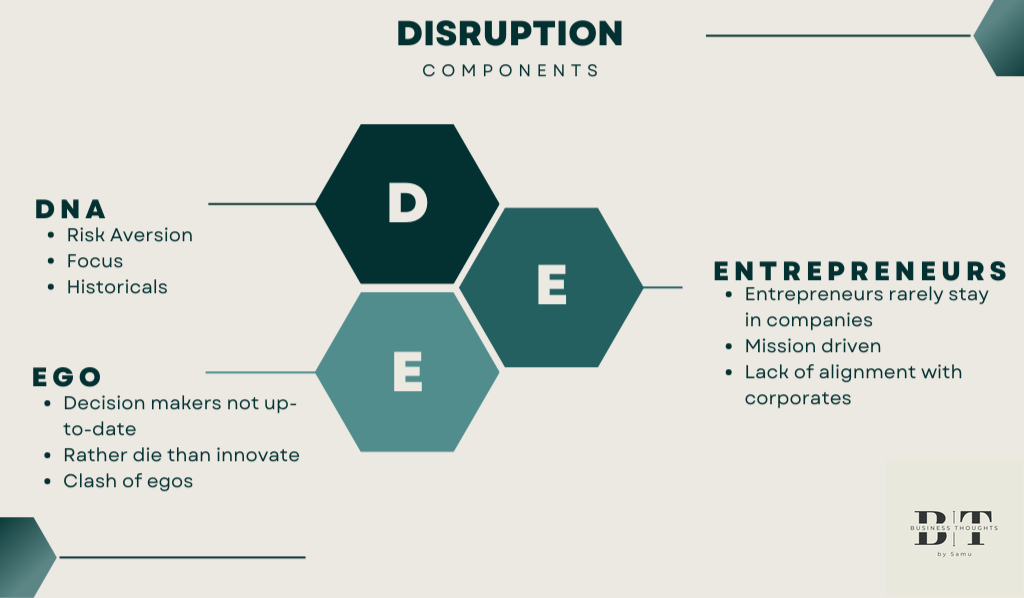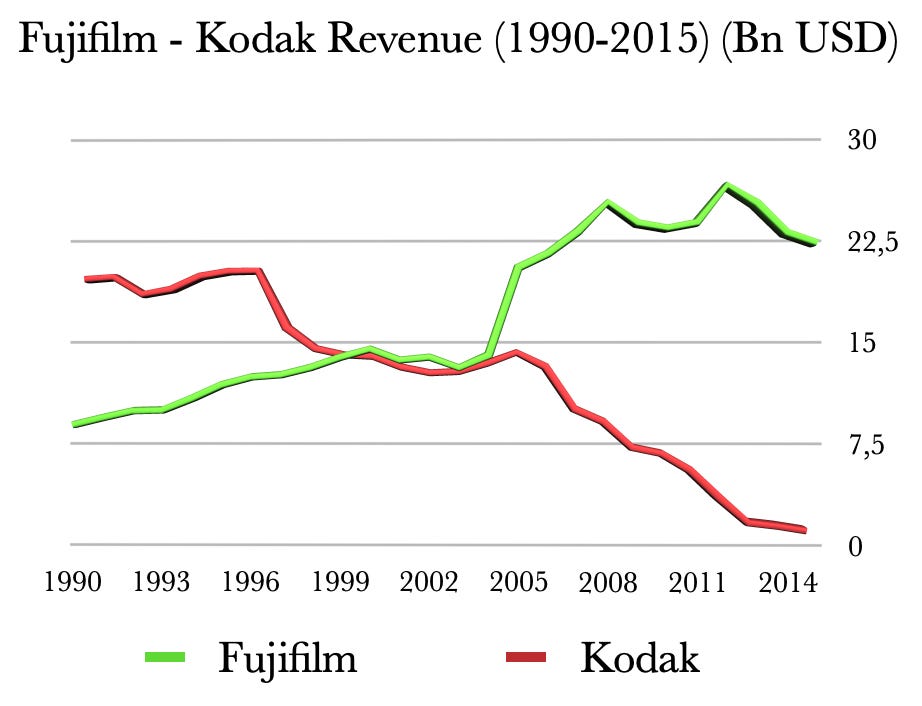Why existing companies are unable to contribute to disruption? (Pt. 2)
Knowing that Product, Price, Knowledge and Business Model are key to disruption, what makes some companies disruptive, while some others don't even try?
Earlier this week, I provided a brief analysis on what does “Disruption” mean and how Product, Price, Knowledge and Business Model can lead businesses to be disruptive.
To sum up the previous post, there are four main ways to disrupt: Product, Price, Knowledge, and Business Model. Click here to read that post.
Now, you might be wondering, if there are four channels to disruption, why are some companies disruptive while others aren’t? Well, like most things in life, it has an explanation.
Historically, the explanations have been based on the fact that existing companies have too much to lose. Conversely, existing companies—and especially larger ones—have little to lose by investing a bit in innovation. However, except for a few occasions, these attempts end up in failure.
So, there must be some other explanations as to why, regardless of their size, existing companies have no luck with disruption, right?
Yes, that is correct. According to Levine, there are three main reasons why existing companies are, most of the time, unable to disrupt.
The 3 Key Elements
DNA - Risk Aversion
It simply does not run in their veins. They are naturally risk-averse, which means their likelihood of starting a disruptive branch is very low, as they will most likely see it as too risky and out of their focus. For example, if Company X is good at harvesting mushrooms and has been doing it for the last 45 years, it sounds reasonable for them to focus on that. Doing something different would divert their focus and pose too much risk.
Lack of Entrepreneurs
Entrepreneurs, due to their personality, do not tend to stay long at existing companies. True entrepreneurs will most likely leave their job at some point to start their own projects. Their need to start a business is so big that they will eventually not fit into their organizations and will either be misunderstood by their management or simply leave to truly contribute elsewhere.
Ego
Existing companies are unwilling to lose focus, not just because of risk, but due to ego. Introducing a completely new division or business model and making it the main focus, telling everyone that their current divisions will lose relevance, would likely ignite a clash of egos and lead to internal conflicts, causing the company to crack down.
To put this into context, imagine you are the CEO of a company in an industry experiencing significant changes. You report to a board of directors, made up of very knowledgeable people, likely above their 60s. Despite their knowledge, their mindsets might not be up-to-date with current challenges, and their opinions are often set in stone due to their successful past decisions. This time, however, is the time for change; it’s either disruption or irrelevance.
Do you really think they would choose disruption?
Some examples of companies failing to disrupt
Blackberry
Who does not remember the very cool Blackberries? They sold over 50 million devices in 2011 alone, averaging around 30 million yearly between 2009 and 2013. There was a huge competition between Blackberry and iPhone, with everyone debating whether to get one or the other, which meant a conflict between keyboard and touch screen. The market was gradually moving towards touch screens, even though Mike Lazaridis did not see it coming.
“I couldn't type on it and I still can't type on it, and a lot of my friends can't type on it. It’s hard to type on a piece of glass.” - Mike Lazaridis, Former Blackberry CEO, April 2008
Kodak
Starting their operations in 1888, Kodak was a market leader in photography and printing. Many attribute the company with the creation of mass-market amateur photography and enabling Hollywood movies and home video.
Kodak’s story is one of innovation for over 100 years. However, they failed to be disruptive when it mattered the most. In 1935, they launched the first color film, a market boom. Then in the 70s, they launched instant films, making photography incredibly accessible to hundreds of millions worldwide.
However, in the 90s, digital films began to appear, slowly but surely becoming more prevalent among professionals and amateurs. Kodak failed to see these signals and delayed their response, giving a significant advantage to other market players. By the time Kodak launched their line of digital cameras, it was too late to compete.
Kodak also tried to diversify into chemicals and healthcare, diverting their attention from their core business.
All this led to the history we know.
Segway
The company started its operations as a result of deep innovation and disruption. No two-wheeled vehicles were on the market at that time, and the Segway’s futuristic look amazed people.
Founded in 1999 by Dean Kamen, the first model, the Segway HT, was launched to the public in November 2002.
Unfortunately, the retail price was quite high, averaging $5,000, which was too steep for a personal mobility device. Additionally, regulatory barriers such as classification, safety, and legality hindered Segway.
Although Segway has not vanished, their initial concept was not as successful as expected. However, they have pivoted to other personal mobility device concepts, such as scooters, with relative success.
At the bottom of the page you will find a couple graphs which give a better idea of the rise and fall of Blackberry and Kodak against their main competitors.
Then what?
Disruption is hard, difficult, and risky. However, companies that try disrupting—bringing in completely new products, knowledge, prices, or business models—tend to bring value to the market, which is often rewarded.
Most likely, what is riskier than disrupting is failing to innovate and focusing on businesses that are not the company’s core.
The examples of Blackberry, Kodak, and Segway illustrate the consequences of missing the signs of change and failing to adapt. While these companies had moments of innovation, their inability to foresee and embrace disruptive changes led to their decline. For Blackberry, it was the reluctance to transition to touch screens. For Kodak, it was the failure to pivot quickly to digital photography. And for Segway, it was the misalignment between product pricing and market readiness. These stories underscore the importance of agility and forward-thinking in maintaining relevance in a rapidly evolving market.
For companies seeking to avoid the pitfalls of their predecessors, fostering a culture that embraces risk and encourages entrepreneurial thinking is crucial. This might involve setting up separate innovation hubs within the organization that operate with a different set of rules and incentives than the core business. By protecting and nurturing these innovation hubs from the risk-averse nature and egos of the main organization, companies can better position themselves to identify and capitalize on disruptive opportunities.
Moreover, leadership plays a pivotal role in driving disruption. Leaders must be willing to challenge the status quo, make bold decisions, and, at times, prioritize long-term innovation over short-term profits. This requires not only visionary thinking but also the ability to inspire and align the entire organization towards a common disruptive goal. As the market landscape continues to evolve, those companies that successfully integrate these principles into their DNA will be better equipped to navigate the uncertainties of the future and emerge as leaders in their fields.
Hope you liked it! Looking forward to your comments!







